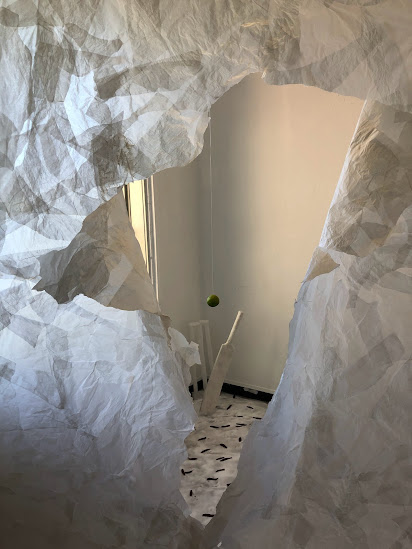Into the Scar
Into the Scar
Tracing Paper, Matte Medium, Salt, Dried Chillies, Lime, Wood, Monofilament, Glass (cups and jars), Water, Paint
Video: Audio:
Process:
This project probably took the most time out of everything I have done this year. Each day week I spent at least 2 hours after school in swig working away at the tracing paper wall and assembling the piece. Then after school, I would do at least an hour of prep work (making the wickets and cricket bat out of tracing paper, making parts of the wall, finding materials, etc.). But I think all those efforts paid off as I was able to create a piece that is meaningful and I am really proud of.
The first week of this project all went towards brainstorming and deciding on an idea. I was stuck between doing something with parts of my playground and bringing them to school and exploring how scars have memories and stories attached to them. I decided on the scar route and began planning. Although I was unable to do exactly what I initially planned, I am still extremely happy with my work and honestly like it even more than what I had originally thought of. Below are some pictures of my process:
Attaching the wall section by section (creating the section off the wall with tracing paper and matte medium, then hanging and attaching the large sections)
To create the wall, I would rip up tracing paper and then apply matte medium completely to one side and attach another (dry) piece and then coat the dry piece and the place they connect in matte medium. The artwork used up 2.5 bottles of matte medium and 1.5 rolls of tracing paper.
I had to break open the wall I painstakingly created in the shape of the scar the piece is based on. (I will include a picture of my leg later :)).
After completing the piece I was relieved and happy with how it looked.
Walking away from the piece on Saturday and going home. I noticed how cool it looked when you were walking towards it and all the light was being filtered by it.
Thoughts (Artist Statement):
The piece responds to the prompt of memory by exploring how each scar is inextricably tied to a memory, whether good or bad. I specifically looked at a scar on my knee which I got from playing cricket with my brother and other kids in India. Although I laughed at first, when I got home I was extremely upset at how this would be my first ever scar. The tracing paper is broken in the shape of my scar to symbolize how people are looking at the specific memory behind that scar. The transparency of the papery and the fact that people can walk through it illustrates how there is always a memory behind each scar.
My parents and grandparents told me that I had gotten my scar because of dishti, evil eyes or bad energy wished upon you by others through jealousy or comments. In my culture, Dishti can be removed by someone putting salt and chilies in their hands and saying a mantra, then washing away the salt and/or chilies with water. They are essentially saying that 'the bad energy should be washed away as easily as the salt washes away from my hands'. Limes or lemons are also used for other kinds of dishti. I used symbolism throughout the entire inside (ex. floor is made of chilies and salt) to illustrate how the memory is filled with dishti. The water being held in the glasses symbolizes how the dishti was not washed away. The whiteness of the inside except for the chilies and the pungent smell of the chilies illustrates how often rather than the actual memory itself, the feeling behind it is important and more clearly remembered. It also alludes to how details of memories are often changed or forgotten. Likewise, the audio of children playing cricket in the background and speaking in hindi and me speaking in English to my brother refers back to the memory.












.jpg)

Comments
Post a Comment